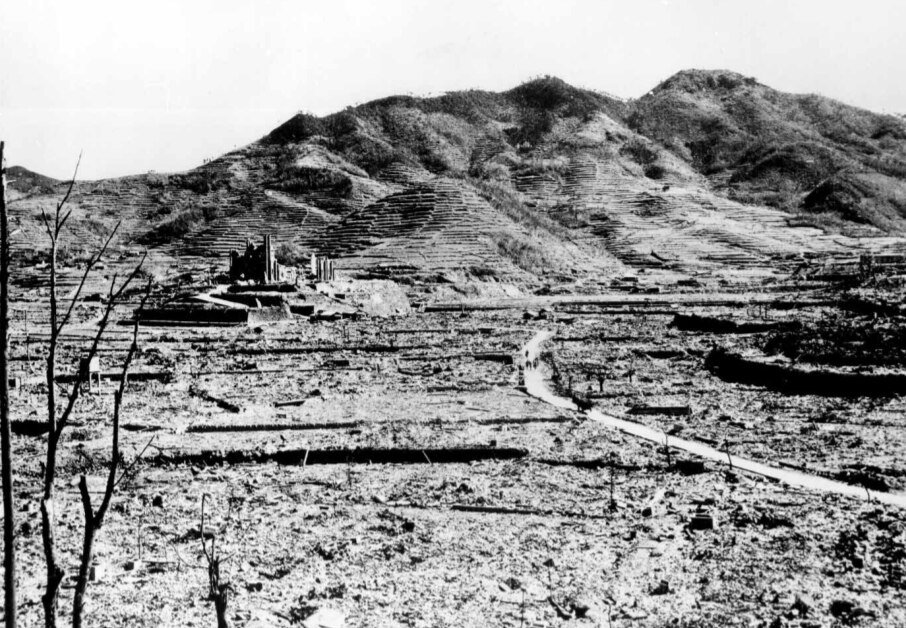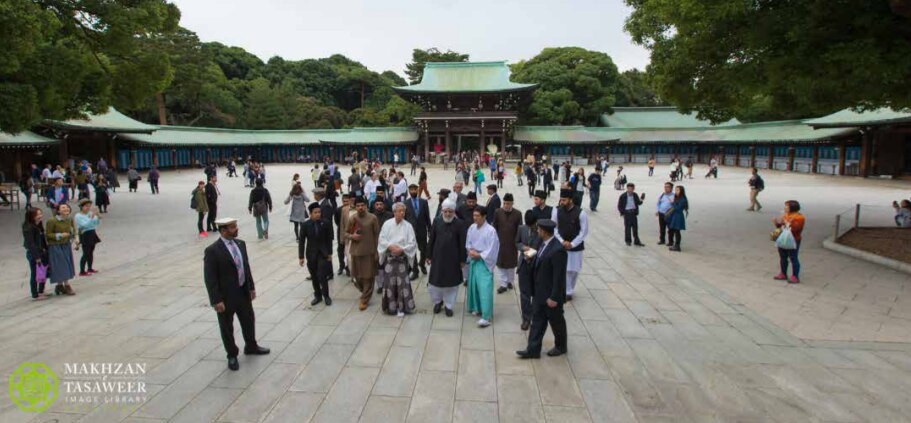Anees Ahmad Nadeem, Missionary-in-Charge, Japan
The state of early Japanese converts to Christianity like “Ashab al-Kahf”[the people of the catacombs]
The lives of early Japanese Christians, who were facing persecution, enduring cruelties, embracing crosses and being forced to blaspheme against Jesusas, were narrowed down to the extent that they had to go into hiding. This period, which began in 1650, is called 隠潅癌義伎岐喫 [i.e. kakure kirishitan] in the Japanese language, which means the “Hidden Christians”.
This period of hiding spanned over the next 250 years. During these two and a half centuries, a new Christian society was born. Christianity moved away from its traditional way and was shifted to homes from church.
In order to save themselves from the wrath of the authorities, the statues of Jesusas and Maryas were carved in the image of Hazrat Buddhaas and placed in homes. As communal worship was not possible, groups of five to 10 Christians were formed, who would secretly arrange joint meetings and festivals with great caution.
After the prohibition of Christian terms and religious rites, attempts were made to keep Christianity alive through substitute words. There was a soft spot for Christianity in the rural areas as the early converts to Christianity in Nagasaki were feudal chiefs and landlords, so some people left the city of Nagasaki and settled in the villages.

Terms and rituals of the period of hiding
In the said age of hiding, Christian adherents moved from the big cities to the countryside, but even in the villages, a cautious lifestyle was maintained. A secret but orderly system was established for the Christians in the villages. A party of five to 10 members was formed and a head would be appointed for each group.
Regarding some of the religious terms of that period, one researcher states:
“During the ban on Christianity, Hidden Christians in the Nagasaki region maintained village-based faith organizations, which had been taking root since the sixteenth century. These small organizations had religious leaders who conducted rituals and taught catechism. The person in charge of keeping the liturgical calendar was called chōkata (帳方), and those responsible for baptisms – which they performed by themselves in the absence of missionaries – were called mizukata (水方)”, the one with water. (The Triumph of Perseverance: Kakure Kirishitan in Japan and its Inscription on the World Heritage List by Joanes da Silva Rocha [2018], p. 168)
In the same way, the person in charge of information and communication was called 聞 鰍 役 [i.e. kikiyaku], which literally means the one with the ears. (The Age-Old Ritual Practice of Ohatsuhoage among the Kakure Kirishitan Survivors by Roger Vanzila Munsi, p. 5)
Due to the prohibition of communal worship, the Hidden Christians adopted a new way of communicating. When the new crop would ripe, the Shinto people used to arrange feasts as thanksgiving. The early Japanese Christians, who were long concealing their faith, also began to arrange similar feasts.
The said festival was called 樫初穂革括 [i.e. Ohatsuhoage] in Japanese (Ibid). It literally means the first provision or the first gift. This word would not even hint that it was related to any religious worship or Christianity and anyone who heard of it would consider it a gratitude for the harvest. These feasts were usually held on Sundays. Apparently linked to the harvest season of crops, those repasts were actually held for the gathering of Hidden Christians and their communal worship.
The birth of a new sect by the name “Hidden Christians”
In The Japan Times, Linda Sieg states:
“Many [early Japanese converts to Christianity] joined Buddhist temples or Shinto shrines to disguise their beliefs, and some rites such as confession and communion, which require a priest, disappeared. Other rituals blended with Buddhist practices such as ancestor worship or indigenous Shinto ceremonies. Handed down orally and in secret, orashō chants – from ‘oratio’ in Latin – combined Latin and Portuguese with Japanese, their meanings mostly symbolic.
“When the ban on Christianity was lifted in 1873, some ‘Hidden Christians’ joined the Catholic Church; others opted to maintain what they saw as the true faith of their ancestors.” (www.japantimes.co.jp/news/2019/11/20/national/history/japan-hidden-christians-religion-last-generation/)
Regarding those early Japanese Christians who remained on their ancestral faith, the seventh-generation head of a group of Hidden Christians in the city of Nagasaki’s Sotome district, Shigenori Murakami, said:
“They [Hidden Christians] didn’t want to destroy the faith they had preserved all along despite suppression.” (Ibid)
Despite religious freedom, the early Japanese converts to Christianity, who adhered to the rituals and rites of the hiding period, were sometimes discriminated against by other Christian sects and were considered a separate religion from Christianity. However, within a few years of the lifting of the ban, the majority of the said Christians became affiliated with the Roman Catholic sect.
Pope John Paul II and Pope Francis visited the monuments of the Hidden Christians during their tours to Japan and paid tribute to them.
Many early Christians of Japan, who gave sacrifices according to Christian customs and traditions, have been given the title of saints. A lot of monuments of the Hidden Christians have now been declared Japan’s national heritage and many places have been declared World Heritage Sites by UNESCO.
The end of persecution and the unearthing of the Hidden Christians
In 1854, a treaty signed between the United States and Japan brought an end to Japan’s self-imposed seclusion and the policy of national isolation. Moreover, the efforts to restore the status and rank of the emperor of Japan, who was considered a symbol of unity and respect, achieved success, and then started the historic reign of Emperor Meiji in 1868.
Following that great change, the people of Japan once again began to return to unity and harmony after division and discord. With the end of the national isolation policy, Japan’s long period of seclusion from the international world also came to an end, and the visits of Western traders and diplomates resumed as relations with the foreign countries were restored.
As the environment became favourable, the Hidden Christians began to emerge in droves and the unearthing of thousands of Christians in the surrounding areas of Nagasaki and southern Japan was a surprising fact.
A long and dark night had passed for the said Christians. A bright morning was dawning upon them and a message was hidden in the said event for the Christian world that the long wait was ending and the second coming of the Messiah was near.
Appearance of the embodiment of Prophet Jesusas, the Promised Messiahas, and the announcement of religious freedom in Japan
Based on the wisdom of Allah the Almighty, it was an astonishing stroke of divine providence that in the 31st year of the Meiji emperorship in February 1889, just one month before the establishment of the Ahmadiyya Muslim Jamaat, the announcement of religious freedom was made all across Japan. The issuance of the Meiji Constitution of Japan brought Japan closer to the international community, ending centuries of religious restrictions and violence, and the appearance of the Promised Messiahas allegorically proved to be the true saviour of the Christians of Japan.
Tribute to King Meiji
During his tour to Japan in November 2015, the worldwide head of Ahmadiyya Muslim Community, Hazrat Mirza Masroor Ahmad, Khalifatul Masih Vaa visited one of the most sacred places of Shintoism – the Meiji Shrine. The arrival of the Khalifa of the Promised Messiahas in a Shinto worship place was in itself an historic event.

On this occasion, Hazrat Amirul Momineenaa, while writing his message, asked the head of the shrine, what the role and efforts of King Meiji were for the establishment of peace.
The chief of the shrine replied that the Meiji era held special significance for world peace and freedom of religion.
On this, Hazrat Khalifatul Masih Vaa wrote the following memorable Quranic words to King Meiji:
اَللّٰهُ نُوۡرُ السَّمٰوٰتِ وَ الۡاَرۡضِ
“Allah is the Light of the heavens and the earth” [Surah al-Nur, Ch.24: V.36].
“Allah reward the Emperor Meiji for his peace creating work in the country and the world.”
According to the Japanese beliefs, the status of their king is like a god. Thus, on the one hand, the message of Hazrat Amirul Momineenaa was a tribute to King Meiji, but on the other, it was an extraordinary pronouncement of the Oneness of God Almighty and Huzooraa also conveyed this message to the Japanese nation in a very wise way that the Light of the Heavens and the Earth is only the Supreme Being of Allah the Almighty.

During the said visit, the Japanese hosts invited Hazrat Khalifatul Masih Vaa and his associates for a dinner. This dinner was arranged in the historic hall where that constitution of Japan was passed in 1889, which granted religious freedom to the people living in Japan.
Shedding light on the religious life of the people of Japan, the Promised Messiahas said:
“The Japanese are seeking for a better religion.” (Malfuzat, Vol. 4, p. 351 [1988 edition])
In this journey for the search for a better religion, the Japanese nation sometimes embraces the teachings of Confuciusas and sometimes takes refuge in the philosophy of the Buddhaas. The Shinto doctrine also does not quench the thirst of the Japanese people and as a result, the inhabitants of Nagasaki not only accepted Christianity by enthusiastically welcoming it, but also embraced crosses following the Christian practice. However, it seems that this journey of trying to find a better religion is still ongoing and the final destination for the satisfaction of heart and the climax of this journey is hidden in the worship of the One and True God, Allah the Almighty.
Hazrat Musleh-e-Maudra said:
“We should not feel anxious by long period of hardships. The Christian people before us were made to suffer for 309 years, but they showed steadfastness and were ultimately rewarded with the sweetest fruit because of their patience. Thus, you should not hasten; rather, you should always be engaged in your work and face hardships with perseverance.” (Tafsir-e-Kabir, Vol. 4, p. 441)
(Translated by M Adam Ahmad, Al Hakam)

